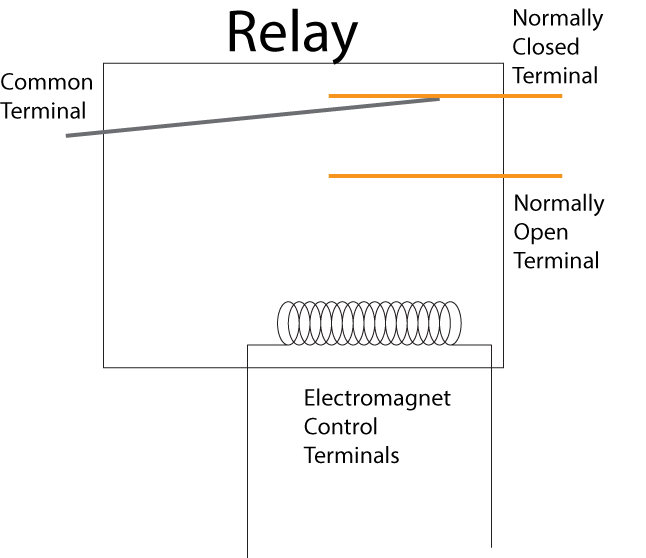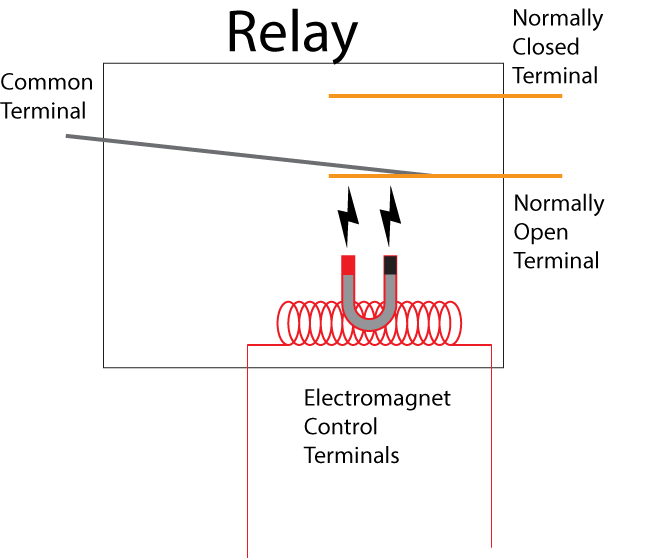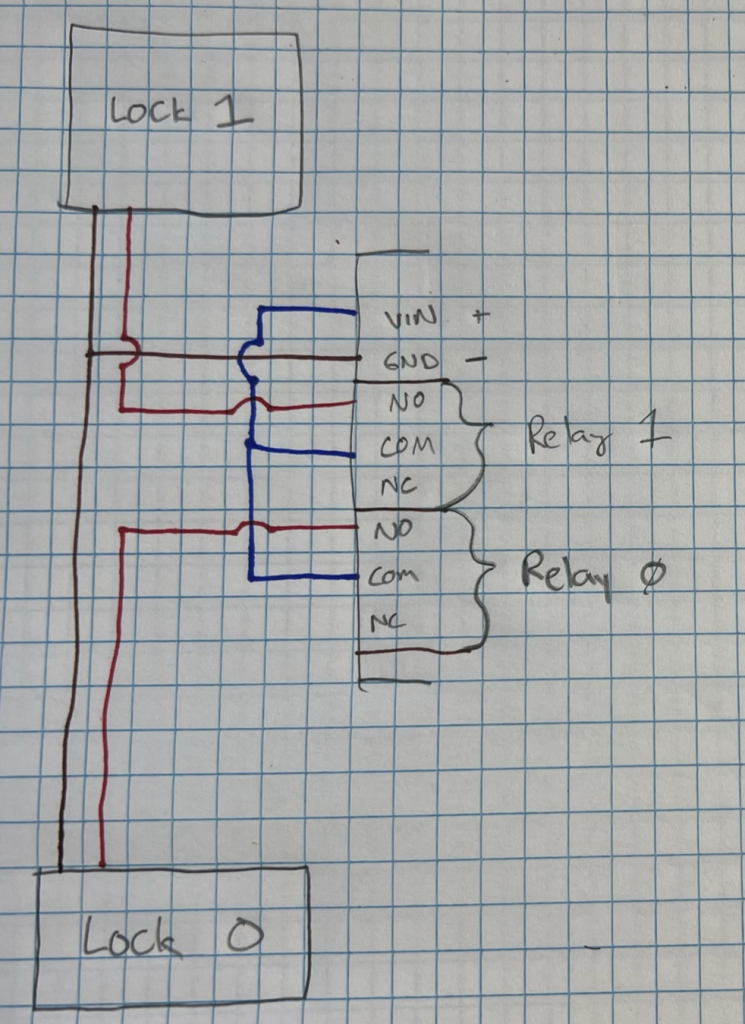One of the most common goals of an event on the BAC is to cause an action to occur elsewhere. This typically is accomplished by completing a circuit to supply power to some other electrical component, like a magnetic lock or a light.
The BAC offers two ways to control external devices – a relay and a digital output. Since both can be used in similar scenarios, the differences can be pretty confusing at first glance!
Digital Outputs
Think of digital outputs as a computer-controlled power supply.
The digital outputs (on the top row of the BAC, numbered 0 through 5) directly supply power to external devices using the same source power supply as the controller itself.
Depending on the revision of the BAC you have and the configuration in BAM, these may be “high side” (each output replaces the + terminal, and the other wire connects to GND) or “low side” drivers (each output replaces the – terminal, and the other wire connects to +12V). Refer to the BAC manual for details on how to wire them up… but in both cases, the key takeaway is that they share the power supply with the BAC itself.
Unlike Arduino devices, where digital outputs can only safely supply a tiny amount of power at a low voltage, the BAC’s outputs are higher power. They operate at the supply voltage (typically 12V) and can be directly connected to many external devices! Just make sure your current draw needs to stay below the limit indicated in the BAC documentation (typically 500mA at 12V per channel), and your total current consumption has to stay within the maximum capacity of your power supply.
The advantage of these digital outputs is that they are easy to understand and use – just wire a device directly to the output and it gets power when the output is on, and has no power when it’s off. They are also completely silent during operation.
The disadvantage is that you are limited to the same output voltage your controller is operating at (typically 12V), and that you cannot draw more than 500mA (fine for small cabinet mag locks, but potentially an issue for larger door-sized locks or other high current props).
The key takeaway is that these digital outputs are electrically connected with the BAC’s control electronics. That means that electrical interference from devices connected to them could potentially affect the BAC (although we include lots of protections against this happening), and it also means it isn’t always appropriate to use these outputs to control other props that have their own power supply.
Relays
Think of relays as a computer-controlled switch.
What is a relay?
The term ‘relay’ dates back to the very beginning of electrical communication, where early engineers needed to solve the problem of how to send telegraph signals across the country. Wires have resistance and signals degrade over long distances (a problem we even have to contend with in escape rooms!), so there needed to be a way to connect different circuits together to resupply new power every so often into the telegraph network, “relaying” a signal from one circuit to another.
The solution that was developed is very similar to what we still use today! Relays are switches controlled by electricity; when they are turned off, the Common terminal is connected to Normally Closed, and when they are turned on, the Common terminal is connected to Normally Open.
The aspect that makes relays most useful today is that the circuit being controlled is completely electrically isolated from the circuit doing the controlling. The switching happens by turning on a small electromagnet: this attracts and pulls a piece of metal from one contact to another, physically changing the switch’s state. It’s exactly like a physical switch, except with a magnet operating it rather than your hands.
How do relays work?
You can think of a relay conceptually as a flappy piece of metal, switching between two contacts called “normally closed” and “normally open”. When the relay is unpowered, a spring causes this metal to rest against the normally closed terminal:

When you power the relay up, the coil acts as an electromagnet, pulling the flappy metal towards the Normally Open terminal and switching the circuit:

As you can see, there is electrical isolation between the controls and the terminals. A fault in the circuit the relay controls wouldn’t affect the control electronics, because they are separated by air and magnetism inside the relay module.
When would I need a relay instead of a digital output?
There are several situations where a digital output won’t be sufficient and you’ll need to use a relay:
- You need more output current than the digital output can provide.
This typically happens when controlling a large door magnetic lock, which often draw between 650 mA and 1A. - You need a separate power supply or you need a different voltage.
The relay is entirely isolated from the main circuit, so you can use any power supply you prefer. The contacts are rated to handle a large amount of current (the relays themselves are rated to 10A and 125V, but we recommend you not exceed 2A and 24V in escape room applications). - You are controlling a pre-existing prop or signaling an external system.
If you have a prop from another vendor, it’s safe to switch its power supply using the relay without causing any unintended effects caused by sharing power supplies between the prop and the BAC. The relay can also be used to simulate button presses or other switch closures for other controllers; this could be used to safely signal a 5V input pin on an Arduino, for example. - You are out of inputs.
Even if a digital output would be sufficient, you can wire up a relay to achieve the same goals and get two extra outputs without resorting to an FX60 or other expander. In this situation, you would use the + and – terminals from the BAC’s connectors to access the same 12V power supply being used to power the BAC. You lose the electrical isolation benefits, but in many applications the convenience is worth that tradeoff.
What are the pros and cons of a relay?
Pros: The relay is isolated from the main circuit, so it’s safe to use the relay to control external devices with different power supplies or power requirements. The relay can also handle much more current than the normal digital outputs.
Cons: Relays make a soft telltale clicking noise when they switch, which can occasionally be problematic in some escape room applications by telegraphing to players that something has changed in the room. They also are mechanical devices, so they can eventually wear out if switched repeatedly (although we use high quality Panasonic relays in our products to minimize the chance of this occurring). They are also large, so only two relays fit in the BAC case.
How do I wire up a relay as a switch?
Simply insert the relay in series into your circuit as if it were a regular switch. Wherever you would normally connect a switch, connecting COM to one terminal and either NC or NO to the other.
If you want the relay to connect (close) the circuit when it’s on and disconnect (open) the circuit when it’s off, connect to normally open. (Usually used for activating special effects or solenoids.)
If you want the relay to disconnect (close) the circuit when it’s on and connect (close) the circuit when it’s off, connect to normally closed. (Usually used for magnetic locks which should be locked by default until the player solves a puzzle.)
It’s okay to switch either the high or low side for most escape room applications – we recommend whichever side your BAC is configured to switch for its digital outputs for consistency.
How do I wire up a relay as a spare digital output?
If you just want to use the relay as an extra digital output, you can source power from the + and – terminals as shown in this diagram:

